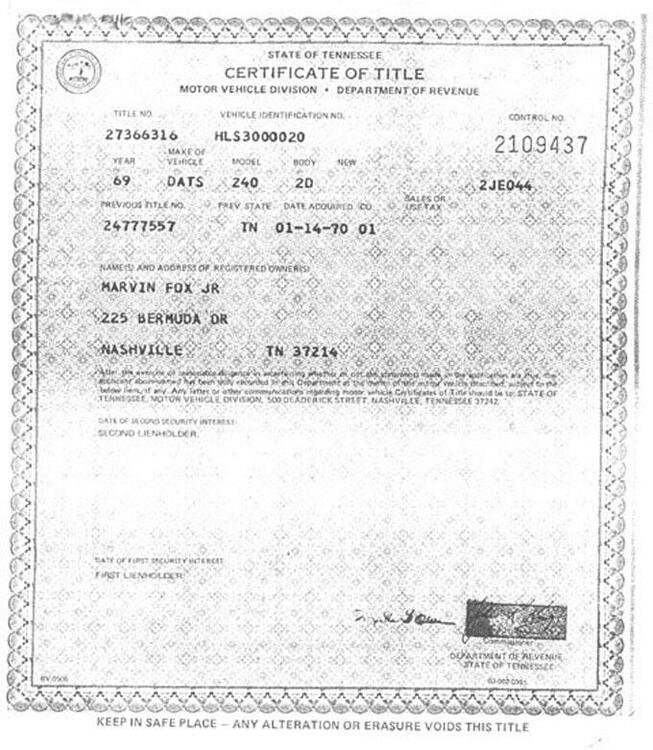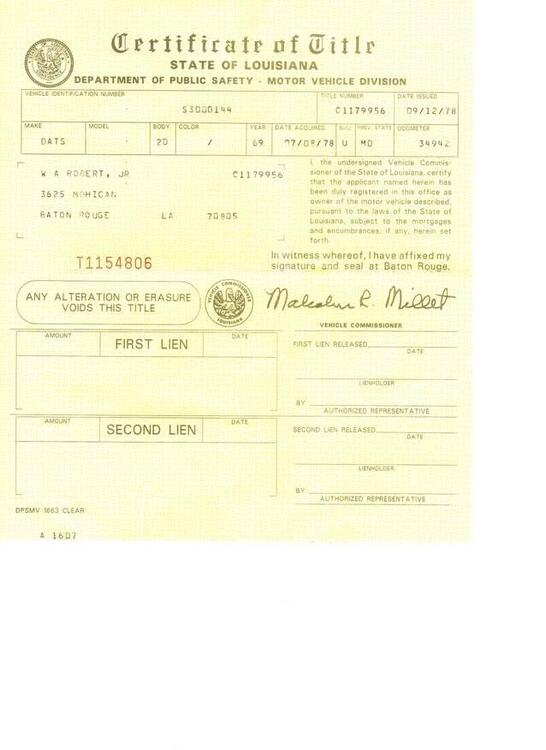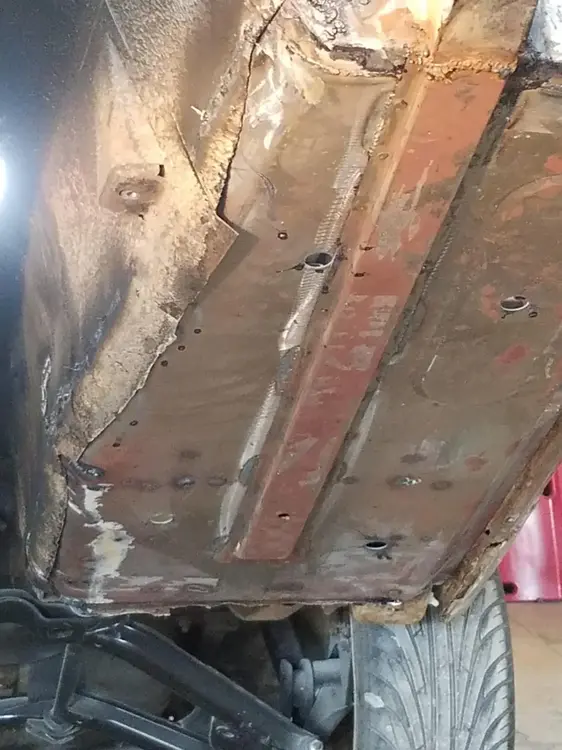Everything posted by Carl Beck
-
Z's on BAT and other places collection
Yes, and several others found out that you can not drive a 240Z over the concrete parking stops at the shopping mall or grocery store. (without getting hung up or damaging the frame rails).
-
Z's on BAT and other places collection
They were titled as whatever the Dealer put on the original application for a new title at the local DMV, in any of the 50 States. In the 50's, 60's and even into 1970 many Import Car Dealers held their Model Year consistent with whatever was common practice in the country of origin. Many of the early Datsun Dealers were already Import Car Dealers when they took on the Datsun Brand. So they followed their normal practice when applying for a new car Title. VW for example held their model year consistent with the calendar year, as did Porsche and Jaguar as I recall. So if a VW was produced on say 31 Dec. 1960 it was titled as a 1960 VW no matter when it was sold, if the VW was produced on 3 Jan 1961 it was titled as a 1961 VW (even though there was no real difference between them). At that time, part of the reasons given to buy a VW Bug, was that there was no "Planned Obsolescence” due to changing the model completely every year as was done by the American Mfg.s. in the 50’s and 60’s. If you drove a Bug it always looked like a new one! The downside to holding the model year consistent with the Calendar Year for the Import Car Dealers, was that their “new models” arrived at the US Dealerships about three months after the First of the Year. That was 5 or 6 months after the New Models from the American Manufactures went on sale. Model Years also affected Resale Values later in the market - as cars depreciated year by year - a car tilted as a 1960 VW was worth less in the resale market than one titled as a 1961 model. (in the eyes of the banks that loaned the money - as well as the customers buying them). Over time, with increased competition and new laws/regulations from the Federal Government; Domestic and Import Car Sales practices started to normalize. Nonetheless today looking back 40 or 50 years everything looks abnormal.
-
Z's on BAT and other places collection
Now 50+ years later, it is impossible to know for certain. It is certainly “possible” that one or two newer or older parts made their way onto the wrong car. Possible but with a very low probability. If we were talking American Cars with the UAW workers on the line - yes - high probability of things screwed up. A world class car assembled in Japan by workers with great company pride and Total Quality Control training etc. … very low probability IMHO. The highest VIN we have recorded so far for a Series I HLS30 240Z, is HLS30 20533. Purchased from the original owners family and refreshed by a friend of mine. In the exchange of pictures and information over the months he worked on the car, we did not find any of the Series II changes or improvements on that 240Z. (it was an A/T car BTW) Another outlier - is HLS30 19860, a Series I example that should have finished production in 01/71, but did not -and was finished in 02/71. It was advertised for sale on BAT in 2017 and pretty completely discussed at the time - but none of the Series II changes seemed to be present on that Z at that time.
-
Z's on BAT and other places collection
According to the Date of Mfg. on the cars - production started in 08/72 and ended in 08/73. Highest VIN for 1973 found so far is HLS30 172767.
-
Z's on BAT and other places collection
- Z's on BAT and other places collection
No - by the 1973 Model Year the US Emissions and Safety standards required both here. Flame retardant interior materials were also mandated for 1973 here.- Z's on BAT and other places collection
- Z's on BAT and other places collection
Yes, I'd say late 80's to early 90's. Before that there was constant confusion caused by indirect, misapplied or misunderstood terms. Like early 71 or late 71. (how early is early? early in what year? which year - the model year or the calendar year? etc etc. Once we realized that Nissan had documented the 4 model series (1970, 1971, 1972, 1973) in their Technical Service Bulletins we started referring to them. The first segment of chassis serial numbers sold to the public according to Nissan began at HLS30-00013, the second segment of chassis serial numbers started at HLS30 21001, the third at HLS30 46000 and the fourth at HLS30 120001. It avoided all the misunderstanding related to terms like model, year, model year, calendar year. Series I and Series II were needed to individually identify each of the two 1971 Datsun 240Z offered for sale. Then tell the difference between the two different 1971 Datsun 240Z's in the marketplace. Looking back at my notes: "The Z Car List" was started in 1987 by Bob Wissman IZCC #176. Before that we had about 300 subscribers on an E-Mail Copy List. The IZCC (a virtual club in the Metaverse) was started by John DeArmond in 1992. #2831 would have been issued in the Feb. of 1996. By 2008 we had over 15,000 subscribers to "The Z Car List". Many new members over the years had just started to look for a 240Z to buy - still asking - what is the difference between early or late 1971 Model Year 240Z's? Which is best? How do I tell them apart? etc etc. (you can see from this discussion that all still goes on today)- Z's on BAT and other places collection
"When Nissan switched" what ? When Nissan switched from selling the 1970 design (your term) as a 1970 Model Year offering - to - selling the 1970 design as a 1971 Model Year offering? I don't believe we have that pinned down to a specific month, as it depended on the Dealer and the State they were in. or When Nissan switched from manufacturing the 1970 design - to manufacturing the 1971 design? Kats said earlier Nissan switched in Feb 1971 for exports and in March of domestic market cars. The Technical Service Bulletin gives the beginning chassis serial number as HLS30 21001 - and so far every 240Z (still stock) with that VIN or higher has a manufacturing date of 02/71 or higher.- Z's on BAT and other places collection
While Nissan released all 1971 features at once on the “Late 1971 Model”; If you think about it - releasing a different model while retaining the same “Model Year” for 1971 isn’t the only time Nissan did that. For 1974 Nissan offered two different models of the 260Z here in the US. The original design 260Z based on the 240Z body and then later the 260Z based on the coming 1975 280Z body. We are told that the Fuel Injected L28E was delayed in development and/or in US Emissions Certification, while the new design body proceeded on schedule into production. The result was Nissan continuing to sell the L26 in the new body to meed emissions standards as a 1974 260Z So the 1975 280Z didn’t come on the market until after Jan. 1975.- Z's on BAT and other places collection
Here is the list of 18 features that were all introduced on the "Late 1971 Model", beginning with VIN's HLS30 21001 and HS30 00501. The US Safety and Emissions standards had to be implemented on cars manufactured on or after the date (Month & Year) specified by law. http://zhome.com/History/New71LateP2.htm- Z's on BAT and other places collection
Hi Jim - My BAD... I must have got lost going back and forth on the spreedsheet - of course I have the Original Owner of #15320 listed as 12/70 - matter of fact checking more carefully - I have HLS30 15316 from BAT also as 12/70 DOM. (8 Sept. 2022).- Z's on BAT and other places collection
From the VIN’s I have collected, I have 12/70 starting at HLS30- 15361 and running though #18048. 01/71 starting at 18144 and ending at 20533, It would appear that the Metal Data Tags (Door, Engine and Dash) were produced first on an Addressograph type machine - where serial numbers were stamped sequentially, like the 17770, followed by 17771, 17772 etc.. Then the date the car was finished at the top was hand stamped with a metal number Punch Die (aka Metal Numbered Die) Addressograph/Graphotype Machine https://www.youtube.com/watch?v=85f-H6Bc9BQ- My parts hauler
- - just got my '72.
Here in North America - 1975-1978 we had the 280Z. From 1979-1983 we had the 280 ZX. Because of our every more strict emissions control regulations over the years there were significant changes to the L28E's and L28ET's. The N42 head came on the 280Z, not on the 280ZX. http://zhome.com/ZCMnL/tech/head.htm http://zhome.com/ZCMnL/tech/128combo.html- Z's on BAT and other places collection
The owner made too many costly decisions related to marketing the car. He spent a lot of money getting it running/driving - but stopped far short of spending enough on the cosmetics. One comment was that the undercarriage should have been cleaned up with dry ice blasting (before showing the car). Another was clean/clear and reinstalled all the hard fuel lines and original clamps. Both were sound advice. Although it was unintended, the Z was presented as an unfinished “Project”; where it should have been presented as a true survivor with 95%+ of its original parts still on the car. (still on the car!). A couple bidders saw it as a Diamond In The Rough, and they offered a fair price in today's market, given the need to spend even more on it. The secondary issue then was the need to fix the rust spots on the body, which could easily leave the car with mis-matched paint patches - repaint the entire car and it is no longer an “original paint” survivor… Damned if you do - damned if you don’t.- Z's on BAT and other places collection
We have come a long way since 1997 - when we had to plead with Classic Car insurance speciality carriers for coverage, when the Hagerty was the only one to respond. To now, with them suggesting we increase the agreed values of our Z’s. I think you want to insure against whatever loss you can’t afford to take. You want the coverage limit high enough that your Z would be replaced or repaired rather than Totaled. Much of that depends on the current condition of the Z’s. It would seem that $35K would a minimum number.- Z's on BAT and other places collection
I applaud the seller for full disclosure - but it also may have cost him a sale. First - the body he started with was way to far gone for that shop to handle. Lots and lots of rust damage everywhere, but few pictures showing how it was “all” addressed. My fear would have been a lot of bondo filling small holes everywhere. Second the killer was the quality of the metal work done on the floor pan replacement. Pictures 812, 813, 815… That shop really did not know what they were doing, I wouldn’t touch that car...- Z's on BAT and other places collection
Prior to the Covid shut down, Chis was planning on shipping a Z to me, which would have been offered for sale once it was already in the US. Most of his Z’s he is doing for his collection, however as people get into the hobby their specific interests or priorities change and they adjust their inventory.- Z's on BAT and other places collection
I am not at all current on 240Z values in the Netherlands nor most of Europe - however I do know that Chris Visscher at S30 World on Facebook - has spent a small fortune restoring several 240Z’s. I’m sure he expects to get at least $150K+ for the cars they complete. The war in Europe may put a serious damper on the economy, which in turn will lower all Classic Car values for some time… nonetheless the 240Z’s are relatively inexpensive as 50+ year old classic Sports Cars go.- Z's on BAT and other places collection
A 240Z restored to "as close as it came from the factory”, ie Condition #1 - will cost you $150K+ today. A little farther away, that being with say 10 judging points deducted from a possible 100, would be in the $125K range. (one just sold earlier in that price range, with some owner selected modifications). The restoration work on the one that sold for $70K+ would take a year or two of the owners work, and an addition $60K to $80K to duplicate, on top of the purchase price of the car to start with. $70K for 240Z in that condition was a bargain today.- Z's on BAT and other places collection
Here is another one -that sold for a little more.. $71,500.00 https://bringatrailer.com/listing/1970-datsun-240z-83/- Z's on BAT and other places collection
It is a 240Z with strong demand and weak supply. In #1 Concours Condition they sell for over $125K, in #2 Concours Condition they sell for $90K+ This example would be a good #3 Condition example. Yes, it was missing the “near perfection” mark on several counts, that the fanatic perfectionists can demand and are willing to pay for. On the other hand $60K for an excellent (not perfect) Series I Datsun 240Z, running, driving and done; for less money than it would take today to duplicate it, is a good value for the buyers in that price range.- Z's on BAT and other places collection
Most likely to enable the Z to be towed behind an RV or Motor Home..- Z's on BAT and other places collection
Sold at $20K - - a real steal for someone!! - Z's on BAT and other places collection
Important Information
By using this site, you agree to our Privacy Policy and Guidelines. We have placed cookies on your device to help make this website better. You can adjust your cookie settings, otherwise we'll assume you're okay to continue.











